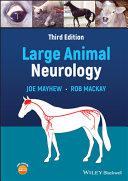Large Animal Neurology 3rd Edition

Publikace je komplexní a autoritativní průvodce neurologickými onemocněními u velkých domácích zvířat. Nově revidované třetí vydání přináší praktické a úplné referenční poznatky pro veterináře, veterinární stážisty a vědce zabývající se neurologií velkých zvířat. Kniha je názorně barevně a fotograficky ilustrována za použití podrobných perokreseb, které zdůrazňují koncepty, o nichž se v ní mluví.
Publikace je uspořádaná do tří částí. Nabízí praktikům a studentům jednoduché návody, jak provádět neurologická vyšetření u domácích velkých druhů zvířat, včetně mlád´at. Probírá také současné klinické syndromy způsobené běžnými nemocemi nervového systému a uvádí podrobnosti o specifických neurologických onemocněních velkých domácích zvířat.
Kniha obsahuje:
Důkladný úvod do hodnocení neurologických pacientů velkých zvířat, včetně diskusí o neuroanatomii, neurologickém hodnocení, pomocných diagnostických pomůckách a důležitých patologických reakcích nervového systému.
Komplexní pojednání o klinických problémech, včetně poruch chování, záchvatů, epilepsie, poruch spánku, slepoty, strabismu, monoplegie, woblerů, tetraplegie, pruritu a syndromu cauda equina.
Podrobný popis specifických postižení, vrozených vad, infekčních onemocnění, včetně postižení nutričního, toxického a metabolického původu a mnoha nemocí s multifaktoriálními a neznámými příčinami.
Autor: Joe Mayhew, Rob MacKay
| Nakladatel | Wiley-Blackwell |
|---|---|
| ISBN | 9781119477037 |
| Vydání | III. vydání 2022 |
| Vazba | pevná |
| Počet stran | 608 |
The newly revised Third Edition of Large Animal Neurology delivers a practical and complete reference for veterinarians, veterinary trainees and scientists dealing with large animal neurology. The book is vividly illustrated in full colour and contains many clinical photographs and detailed line drawings to highlight the concepts discussed within.
Organised into three parts, Large Animal Neurology offers practitioners and students straightforward guides on how to perform neurologic examinations for domestic large animal species, including neonates. It also discusses the presenting clinical syndromes caused by common nervous system diseases, as well as giving details of the specific neurologic diseases of large domestic animals.
The book includes:
A thorough introduction to the evaluation of large animal neurologic patients, including discussions of neuroanatomy, neurologic evaluation, ancillary diagnostic aids, and the important pathologic responses of the nervous system
Comprehensive exploration of 26 presenting clinical problems, including behaviour disorders, seizures, epilepsy, sleep disorders, blindness, strabismus, monoplegia, wobblers, tetraplegia, pruritus and cauda equina syndrome
Detailed coverage of the specific diseases, including those of genetic, infectious, nutritional, toxic and metabolic cause, and the many diseases with multifactorial and with unknown cause
Perfect for all equine and farm animal veterinarians, veterinary neurologists, as well as trainees in the field, Large Animal Neurology, Third Edition is also an ideal resource for undergraduate veterinary students, animal pathologists, and neuroscience researchers.
Review
"An ideal and comprehensive reference for all equine and farm animal veterinarians, veterinary neurologists, as well as trainees in the field, this newly updated and revised edition of "Large Animal Neurology" is also an indispensable resource for undergraduate veterinary students, animal pathologists, and neuroscience researchers."
-Library Bookwatch, Jan 2023, Midwest Book Review
From the Back Cover
A comprehensive and authoritative guide to neurologic disease in large domestic animals, world-wide.
About the Author
Joe Mayhew is Professor of Equine Studies at Massey University, New Zealand.
Rob MacKay is Professor of Large Animal Medicine at the University of Florida, USA.
| Preface to third edition | vii |
| About the companion website | ix |
| Part I Evaluation of Large Animal Neurologic Patients | 3 |
| 1 Practical neuroanatomy | 3 |
| 2 Neurologic evaluation | 11 |
| 3 Ancillary diagnostic aids | 52 |
| 4 Pathologic responses of the nervous system | 75 |
| Part II Clinical Problems in Large Animal Neurology | 91 |
| 5 Disorders of behavior | 91 |
| 6 Seizures and epilepsy | 97 |
| 7 Sleep and acute collapse disorders | 103 |
| 8 Coma and other altered states of consciousness | 107 |
| 9 Blindness | 111 |
| 10 Miosis, mydriasis, anisocoria, and Horner syndrome | 114 |
| 11 Strabismus | 121 |
| 12 Dropped mandible and masticatory muscle atrophy | 125 |
| 13 Decreased and increased facial sensation | 129 |
| 14 Facial paralysis and facial spasm | 133 |
| 15 Pharyngeal dysphagia | 137 |
| 16 Dilated esophagus | 142 |
| 17 Laryngeal paresis and paralysis: roaring | 144 |
| 18 Tongue paralysis | 147 |
| 19 Head tilt, circling, nystagmus, and other signs of vestibular dysfunction | 150 |
| 20 Deafness | 156 |
| 21 Disorders of posture and movement | 159 |
| 22 Incoordination of the head, neck, trunk and limbs: cerebellar diseases | 171 |
| 23 Tetraparesis, paraparesis, and ataxia of the limbs: spinal cord diseases | 175 |
| 24 Diffuse weakness | 181 |
| 25 Paresis and paralysis of one limb: monoparesis | 185 |
| 26 Bilateral brachial paresis to paralysis | 191 |
| 27 Urinary bladder distention, dilated rectum and anus, and atonic tail: cauda equina syndrome | 194 |
| 28 Pruritus, self-mutilation, headshaking, complex regional pain syndrome, and miscellaneous distressing disorders | 198 |
| 29 Autonomic nervous system dysfunction | 206 |
| 30 Vertebral and paravertebral problems: stiff neck and sore back | 210 |
| Part III Mechanisms and Specific Diseases | 217 |
| 31 Congenital, familial, and genetic disorders | 217 |
| 32 Infectious, inflammatory, and immune diseases | 292 |
| 33 Physical, chemical, and thermal causes | 373 |
| 34 Toxic diseases | 412 |
| 35 Nutritional diseases | 481 |
| 36 Metabolic diseases | 503 |
| 37 Neoplasms and other tumors | 521 |
| 38 Multifactorial and idiopathic disorders | 532 |
| Index | 588 |